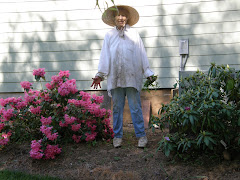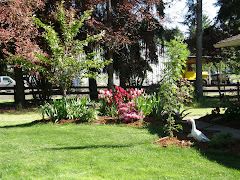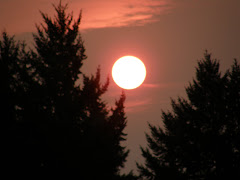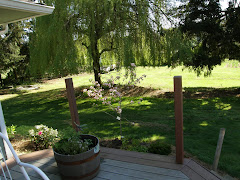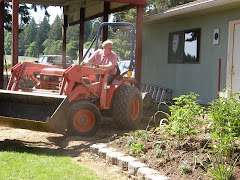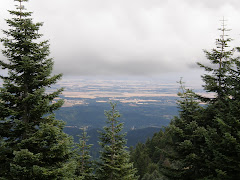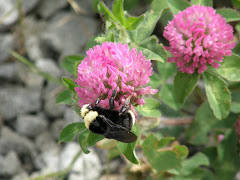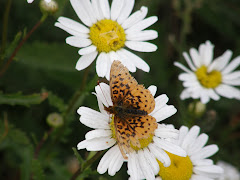This is coming as a comment to my daughter's blog (http://www.lordsofthemanor.blogspot.com/ ) where she shares "a story from the perspective of a farmer's field and how the little leaves are sprouting up happily in the sunshine when suddenly the tractor comes by and dumps a couple tons of manure on top of everything. And our perspective then as the crop is that something really cruddy has happened to us. Then we aren't sure what to do next because we are lost in our perspective of being covered in cow crap (or chicken, because we all know the chicken kind smells so much worse), and we can no longer see the sun and we certainly don't feel like we are growing when we'd just burst out only to be buried in crud again. But from the perspective of the Farmer, we are being strengthened and nourished and in the end will be a much greater crop to harvest. But from our view of things, we always react with feelings fear and avoidance to the sound of the tractor coming.
Having never heard this analogy before, it struck me that after running into my brick wall, I've felt very much covered in chicken shit on top of it all. Being in the refiners fire is a nice thought, but at some point I'm supposed to grow a little here and get my leaves to pop up through to the sunshine again, stronger, but it doesn't seem to be happening. . . ."
I have some thoughts to go along with this analogy--my own little observations from my experience in my own garden and life.
Coming from the gardeners perspective, when we put manure on our gardens, sometimes we actually get more weeds especially if we have used cow or horse manure. Cows and horses eat weeds and those pesky weed seeds manage to survive their digestive systems. That is one reason why chicken manure is a higher quality product to use on the garden. Sometimes also we put too much manure on the garden and it burns the plants we are actually trying to strengthen. And even though the manure can do a great deal to enrich the soil (mostly in adding organic material) the soil can also be lacking in other things that manure can't correct--deficiencies or pests that need other attention.
Sometimes what the soil needs is to lie fallow for a time, allowing the manure and other additives to enrich the soil and give it a rest so in some future time, the soil will be ready to accept new seedlings that will grow and produce an abundant crop.
Also it is interesting that the soil may be depleted with certain crops and yet it will accept others which actually bring back good things into the soil for future use--such as corn which is a heavy feeder versus green beans or peas which put high amounts of nitrogen back into the soil. Corn requires several additions of fertilizer and soil amendments throughout the growing season to produce a high quality and quantity crop. Green beans or peas give their all to produce a bountiful crop and to put good things back into the soil. So the wise farmer or gardener uses the technique of crop rotation so as not to deplete the soil. (This was one problem that farmers had during the "dust bowl" during the 1930's. The farmland was depleted and then winds came and blew off all the top soil.)
Here is another interesting thing about corn and green beans: We could start a total other analogy here. Corn takes so much to get a good crop. It requires good fertile soil, thinning, several applications of fertilizer, but it's yield is only about two ears of corn per stalk. When the growing season is over, the soil is depleted and needs to be built up again. Green beans, on the other hand, need little fertilizer, and aside from building a trellis for certain types, they will continue to produce as long as you water them and pick them. Then they leave the soil better than when you began. I ask myself, am I more like the corn or the green beans. Do I take more than I give? Do I leave things better than they were when I started?
Isn't it interesting that we can apply all these things to our own lives, our own "personal gardens?" Yes, sometimes we get the refining from experiences that the Lord allows us to have to experience growth in our lives as in the analogy of the manure. Because of this we have the opportunity for more and stronger growth in our lives. But sometimes we have more difficult problems that will take more than the manure to make us strong, we need reinforcements--friends, family, faith, etc. Sometimes we need a rest or a change in our thinking, or in the choices we are making, or to look at things from a different perspective. We can gather strength from others which will allow us to continue to grow without getting "burned out." Or perhaps there are people or circumstances in our lives that are actually toxic and are causing us too much difficulty and we need to "weed" them out. Other times we just have to trust in the Lord, the Ultimate Gardener, (isn't it interesting how the Lord uses so many examples of gardening in the New Testament?). The hardest thing is allowing the atonement to work in our lives--allowing the Lord to take our burdens that we are not capable of dealing with on our own. At any rate, it all sounds so easy when we talk about it, but it is a difficult process and one that no one in this life can avoid.
Mushroom and Cheese Stuffed Acorn Squash
9 years ago


 For more ideas on making a stack n whack quilt, check out this website:
For more ideas on making a stack n whack quilt, check out this website:  7. Take one stack of 5 X 5 blocks, place one 5 " square on your work surface, place another identical sqare next to it, but turn it one quarter, continue on with each of the four blocks setting them up to make a block. As you do this, you will see a Kaleidoscope pattern in the block. Play with your block until you are satisfied with the outcome, then stitch them together with a ¼ inch seam allowance. Press finished block. Here are the four identical 5X5 squares before I rotated them into sewing position. You can see that depending on which corner of the squares I put in the center, I will have a completely different block. You also can get a real twist in the block which makes it very interesting. Original four 5" identical squares:
7. Take one stack of 5 X 5 blocks, place one 5 " square on your work surface, place another identical sqare next to it, but turn it one quarter, continue on with each of the four blocks setting them up to make a block. As you do this, you will see a Kaleidoscope pattern in the block. Play with your block until you are satisfied with the outcome, then stitch them together with a ¼ inch seam allowance. Press finished block. Here are the four identical 5X5 squares before I rotated them into sewing position. You can see that depending on which corner of the squares I put in the center, I will have a completely different block. You also can get a real twist in the block which makes it very interesting. Original four 5" identical squares: With each block, you will have four choices of how you want your final block to appear. From these original squares, here is choice #1:
With each block, you will have four choices of how you want your final block to appear. From these original squares, here is choice #1:

 Choice #4. Notice the wreath affect in the middle of this one:
Choice #4. Notice the wreath affect in the middle of this one: Which block do you like the best? I don't know. They are all beautiful and it is entirely your own taste. Now can you see that every single block cut from one piece of fabric could appear to be cut from a completely different fabric? It really makes your quilt look like you have spent hours searching for fabric or fussy cutting each block! It is very impressive.
Which block do you like the best? I don't know. They are all beautiful and it is entirely your own taste. Now can you see that every single block cut from one piece of fabric could appear to be cut from a completely different fabric? It really makes your quilt look like you have spent hours searching for fabric or fussy cutting each block! It is very impressive.

 Nathan, Jim, and Mary. Half of the south side is finished.
Nathan, Jim, and Mary. Half of the south side is finished. SLACKER!
SLACKER!


